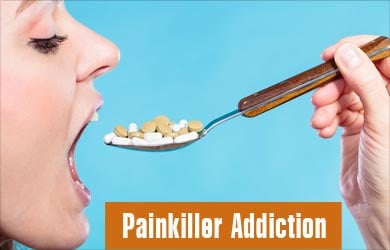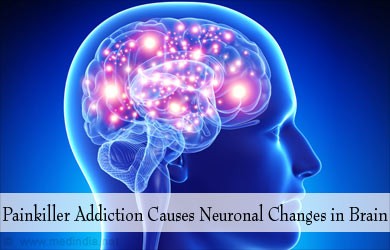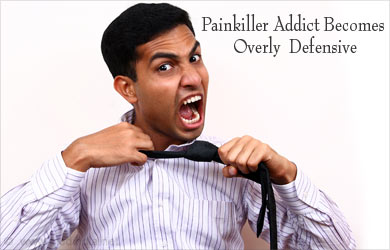- Prescription Painkiller Overdoses - (http://www.cdc.gov/vitalsigns/prescriptionpainkilleroverdoses/index.html)
What is Painkiller Addiction?
Drug addiction is a chronic and relapsing brain disease that causes a craving for drugs, in spite of harmful consequences that might occur to the addicted individual and to those around the addicted individual.
Non-medical use of prescription drugs such as opioids, central nervous system depressants, stimulants can cause abuse and addiction. A painkiller addicted individual behavior is different from that of a normal person.
Drug addiction is a state of physical or psychological dependence on drug and can lead to serious long-term consequences, which include problems related to physical and mental health, relationships, employment and the law.

Causes of Painkiller Addiction
There is no single factor that can say that the person will become addicted to prescription drugs. Addiction is influenced by several factors combined, which include individual biology, social environment, and age or development stage.
- Biology: Genes of a person when combined with environment, influence about half of addiction vulnerability. In addition, gender, ethnicity and presence of other mental disorders may influence drug abuse and addiction.
- Environment: Factors like peer pressure, physical and sexual abuse, stress and parenting quality can also be an influencing factor.
- Development: Genetic and environmental interaction along with critical developmental stages in one’s life thereby affects vulnerability to addiction.
- Changes in Brain: Physical addiction to drugs occurs on its repeated use and the way the brain feels pleasure. The drug causes physical changes to nerve cells (neurons) in the brain. These changes remain long even after the drug is stopped.

Risk Factors for Painkiller Addiction
- Family history
- Genetic association
- Age
- History of mental health disorders
- Use of psychiatric medication in the past
- History of drug abuse
- History of chronic pain
Signs of Painkiller Addiction
- High Use: People taking prescription medicines over the time can become tolerant to the effects of prescribed dose. If an individual is increasing the dose over the time, it is an indication that the dose prescribed earlier no longer provides relief.
- Personality Changes: Behavioral changes in a person can be a sign of dependency. As painkillers provide relief, there may shift in energy, mood and concentration and daily responsibilities may become secondary.
- Continued Usage: Ongoing use after the improvement in a medical condition can make person ask extension on the prescription. The person may describe how they still feel the pain and would require medication to be continued for a longer period to get completely well. An addicted person may also frequently complain about doctors refusing to write prescription for some or the other reason.
- Getting Prescriptions: An addicted person will spend a considerable amount of time by driving great distances and visiting multiple doctors for obtaining drugs.
- Being Defensive: In an attempt to hide drug dependency, the addicted person can become overly defensive if they feel that their secret will be revealed. They might also even react on simple request made by shouting.

- Avoiding Responsibilities: Addicted person may always call themselves sick for work and neglect daily household chores and bills.
- Forgetfulness & Darkness: Clear indication of dependence or addiction is when the person keeps on forgetting events that have taken place.
- Increased Sensitivity: There would be heightened sensitivity or overly stimulating towards normal sights, sounds and emotions. Hallucinations, though occurring as well may be difficult to monitor.
How to Prevent Painkiller Addiction?
Preventing prescription painkillers over dependence in patients depends on many levels. The following are the initiatives that need to be taken by important stakeholders:
Government:
- Track prescription drug overdose and educate health care providers and public regarding prescription drug misuse, abuse, suicide, overdose and risks associated.
- Develop and evaluate programs and policies for preventing and treating prescription drug abuse and overdose, thereby making sure that patients have access to safe and effective treatment for pain.
- Work to improve access to mental health and substance abuse treatment
Health Care Providers:
- Recognize the fact that large number of prescribed painkillers is being overdosed.
- Discuss pain treatment options, including the ones that don''t have prescription drugs.
- Discuss the risks and benefits associated while taking prescription painkillers.
- Follow guidelines for the prescription of painkillers, including screening and monitoring of abuse to any substance and mental health problems.
- Prescribe only the quantity that is sufficient by appropriate diagnosis.
- Use patient-provider agreements coupled with urine drug tests for those who will be using prescription painkillers for long.
- Refrain from prescribing combinations of painkillers and benzodiazepines (like Xanax and Valium), unless required for a specific medical condition.
- Use of prescription drug monitoring programs that track all prescriptions for controlled substances in the state for identifying patients who are improperly using prescription painkillers and other medicines.
- Guide patients on safe use and dispose of painkillers.

States:
- Take steps in improvement of prescription drug monitoring programs, like real-time access to reporting data, integration with electronic health records, unsolicited reporting, incentives provider use and co-operative operability with other states.
- Identifying improperly prescribed painkillers and other prescription drugs through prescription drug monitoring programs and other data validation schemes.
- Increasing access to treating substance abuse and providing immediate access to affected individuals.
- Consider steps that cause a reduction in barriers to prescription drugs.
Patients:
- Use prescription drugs only as told by the healthcare provider and store it in a secured place.
- Dispose of all medications in the right manner as soon as treatment course is completed.
- Stopping abuse of prescription of painkillers and medicines by selling or sharing with others.
- Not using other person's prescription drugs.
- Get appropriate help from support groups when required.
- Discuss all medications that are being taken (including OTC preparations) with the doctor.








